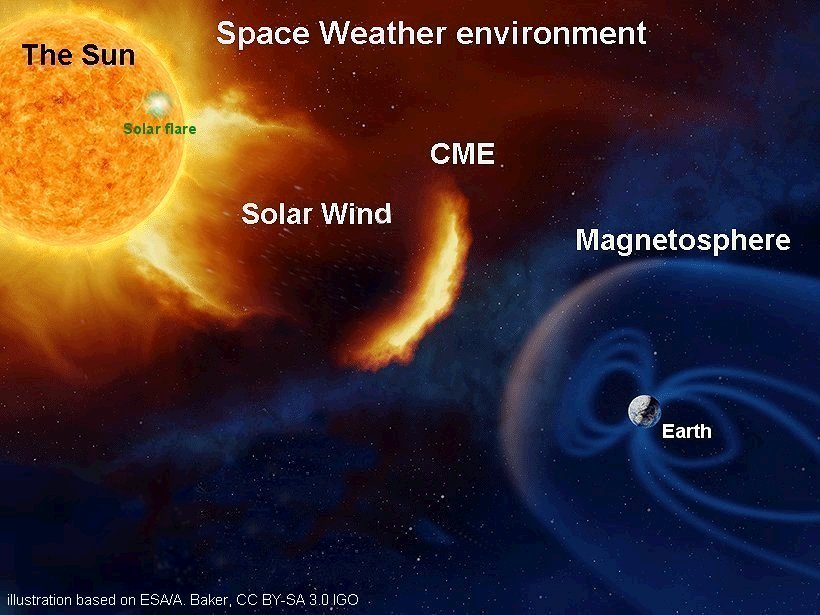
 What is Space Weather?
What is Space Weather?
Space weather refers to the conditions and events in space that can impact Earth and its environment, driven by the Sun's activity, including solar flares, coronal mass ejections, solar wind, and other solar radiation.
When these phenomena interact with the Earth's Magnetic field and atmosphere, they can cause a range of effects, including geomagnetic storms, auroras, and disruptions to communication and navigation systems.
Space weather effects
NOAA introduced space weather scales that describe the environmental disturbances for three event types: geomagnetic storms, solar radiation storms, and radio blackouts. These scales have numbered levels, analogous to hurricanes, tornadoes, and earthquakes that convey severity.
Space weather is an important area of study because it has significant implications for a range of technologies and systems that rely on reliable communication and navigation, including power grids, satellites, and airlines. Severe space weather events can cause power outages, disrupt communication and navigation systems, and expose astronauts and airline passengers to increased levels of radiation.
Space weather environmental parameters
In terrestrial meteorology, there are several environmental parameters such as temperature, pressure, humidity, wind speed and direction, and precipitation. These values change with time and with place.
Space weather indices include sunspot number, geomagnetic indices, solar wind parameters (density and speed), solar x-ray flux, and many more.
To monitor and predict space weather, scientists use a range of instruments and observatories, including ground-based telescopes, satellites, and spacecraft. Space weather forecasts are issued by national meteorological and space weather agencies, and are used by various industries to prepare for and mitigate the effects of space weather events. Space weather research is an ongoing area of study, and is critical for understanding and managing the potential impacts of solar activity on the Earth and its environment.
See: Why is Space Weather relevant to HF propagation? See also an index of terms for HF Radio propagation.
- References:
- Space weather: What is it and how is it predicted? Space.com
Space Weather refers to variations in the space environment that are a consequence of charged particles and electromagnetic radiation emitted from the sun. - What Is Space Weather? NASA Space Place
Activity on the Sun’s surface creates a type of weather called space weather. The Sun is really far away—about 150 million kilometers (93 million miles)—from Earth. However, space weather can affect Earth and the rest of the solar system. - What is space weather? ESA
Space Weather is the physical and phenomenological state of natural space environments. The associated discipline aims, through observation, monitoring, analysis and modelling, at understanding and predicting the state of the Sun, the interplanetary and planetary environments, and the solar and non-solar driven perturbations that affect them, and also at forecasting and nowcasting the potential impacts on biological and technological systems. -COST Action 724, 2009 - What is space weather? UK Met Office
Space weather is a consequence of the behaviour of the Sun, the nature of Earth’s magnetic field and atmosphere, and our location in the solar system. The active elements of space weather are particles, electromagnetic energy and magnetic fields, rather than the more commonly known weather contributors of water, temperature and air. Magnetic fields, radiation, particles and matter which have been ejected from the Sun can interact with the Earth’s magnetic field and upper atmosphere to produce a variety of effects. - What is Space Weather and How Does it Affect the Earth? UCAR - University Corporation for Atmospheric Research
Space weather is very different from weather on Earth. Weather on Earth involves atmospheric conditions, such as temperature, humidity, and air pressure, that can produce storms with precipitation and wind. In the vacuum of space, there is no water or air, and thus there also isn’t any precipitation. But there is wind — solar wind - that isn’t air at all, but instead is a stream of energy and plasma, or charged particles, from the Sun. Space weather storms are invisible but still impact Earth. - What Is Space Weather And Who Should Forecast It? A hearing at US Gov
- What is Space Weather? University of New Hampshaire
"Conditions on the Sun and in the solar wind, magnetosphere, ionosphere and thermosphere can influence the performance and reliability of space-borne and ground-based technological systems and can endanger human life or health." —NASA Space Weather Center Changes in the Sun's energy flow cause changes in the space environment near Earth, termed "space weather." While the sun emits a continuous stream of ionized gases, called solar wind, it periodically releases a large burst of this charged matter, called a coronal mass ejection (CME).
When directed toward Earth, these magnetic storms can affect the space-borne electronics and ground-based technologies. On occasion, intense magnetic storms can disrupt a power grid or radio and satellite signals, but fortunately the magnetosphere protects us from most of the effects of CMEs.
Some magnetic energy does transfer through the magnetosphere near the North and South Poles, where the magnetic field is weaker. This produces colorful auroras in the higher latitudes.
- What is Space Weather? Australian Government Bureau of Meteorology
The term "space weather" refers to events beyond the Earth's atmosphere that impact upon our technology and the near-Earth space environment. The primary source of space weather is the sun, with the greatest disturbances usually caused by solar flares and subsequent geomagnetic storms.
shows near-real-time indices and explains what the terms mean.
